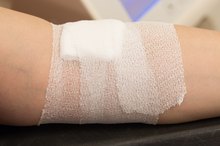What Are the Treatments for Skin Bleach Burn?
You can suffer a chemical burn by spilling bleach on your skin 1. If your burn is severe, you need to seek immediate medical attention. You also need medical attention if you show signs of shock; have an all-over body reaction; have a burn over an area bigger than 3 inches that penetrates more than your first layer of skin; or have burned your eyes, the area over a major joint, your buttocks, face, feet, face or groin. In addition, if you haven’t had a tetanus shot within the past five years, the experts at the Mayo Clinic advise you to get one because all burns are susceptible to tetanus 2. Burns caused by bleach that do not require an emergency room visit still need immediate treatment to reduce the amount of damage to your skin.
Flush the Area
The initial treatment for a chemical burn from bleach is flushing the bleach off your skin using cool running water, according to MedlinePlus, a service of the National Library of Medicine and the National Institutes of Health 1. You need to continue this treatment for 20 minutes or more, according to the Mayo Clinic. Make sure you remove any contaminated jewelry or clothing before you flush. Rewash the burned area for additional time if you experience increased burning after the initial washing.
- The initial treatment for a chemical burn from bleach is flushing the bleach off your skin using cool running water, according to MedlinePlus, a service of the National Library of Medicine and the National Institutes of Health 1.
Pain Releif
Healing Chemical Burned Skin
Learn More
You can relieve pain from your burn in a couple of ways. Apply a cold, wet compress to the burn area, advises MedlinePlus 1. Also take an over-the-counter pain reliever, such as ibuprofen, aspirin, naproxen or acetaminophen, advises the Mayo Clinic experts. However, if the person suffering the burn is younger than 2, do not administer aspirin. Also, if the burn victim is a teen or child who is recovering from flu-like symptoms or chickenpox, do not give the youth aspirin, according to the Mayo Clinic. If your pain is not controllable with an OTC pain reliever, you should seek medical attention.
- You can relieve pain from your burn in a couple of ways.
- Also, if the burn victim is a teen or child who is recovering from flu-like symptoms or chickenpox, do not give the youth aspirin, according to the Mayo Clinic.
Additional Treatment
You need to wrap your burn in a sterile, dry dressing or clean cloth to protect the burned area from friction, according to MedlinePlus 1. If your burn is minor, it will likely heal with no further treatment. Avoid putting any ointments or salves onto your burn, and do not remove dead skin or blisters from the burn area, advises MedlinePlus 1.
Related Articles
References
- MedlinePlus: Chemical Burn
- Mayo Clinic: Chemical Burns: First Aid
- KidsHealth.org: Burns
- Cuttle L, Pearn J, McMillan JR, Kimble RM. A review of first aid treatments for burn injuries. Burns. 2009;35(6):768-775. doi:10.1016/j.burns.2008.10.011
- Lloyd ECO, Rodgers BC, Michener M, Williams MS. Outpatient burns: prevention and care. Am Fam Physician. 2012;85(1):25-32.
- Shrivastava P, Goel A. Pre-hospital care in burn injury. Indian J Plast Surg. 2010;43(Suppl):S15-S22. doi:10.4103/0970-0358.70720
- Nielson CB, Duethman NC, Howard JM, Moncure M, Wood JG. Burns: Pathophysiology of Systemic Complications and Current Management. J Burn Care Res. 2017;38(1):e469-e481. doi:10.1097/BCR.0000000000000355
- Schaefer TJ, Tannan SC. Thermal Burns. In: StatPearls. Treasure Island, FL: StatPearls Publishing; 2019.
- Cancio LC, Barillo DJ, Kearns RD, et al. Guidelines for Burn Care Under Austere Conditions: Surgical and Nonsurgical Wound Management. J Burn Care Res. 2017;38(4):203-214. doi:10.1097/BCR.0000000000000368
- Lloyd ECO, Rodgers BC, Michener M, Williams MS. Outpatient burns: prevention and care. Am Fam Physician. 2012;85(1):25-32.
- Munteanu A, Florescu IP, Nitescu C. A modern method of treatment: The role of silver dressings in promoting healing and preventing pathological scarring in patients with burn wounds. J Med Life. 2016;9(3):306-315.
Resources
Writer Bio
Linda Tarr Kent is a reporter and editor with more than 20 years experience at Gannett Company Inc., The McClatchy Company, Sound Publishing Inc., Mach Publishing, MomFit The Movement and other companies. Her area of expertise is health and fitness. She is a Bosu fitness and stand-up paddle surfing instructor. Kent holds a bachelor's degree in journalism from Washington State University.





